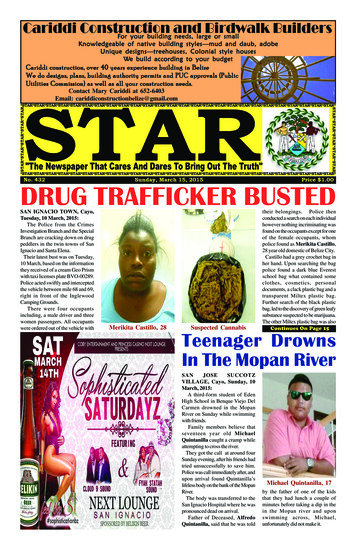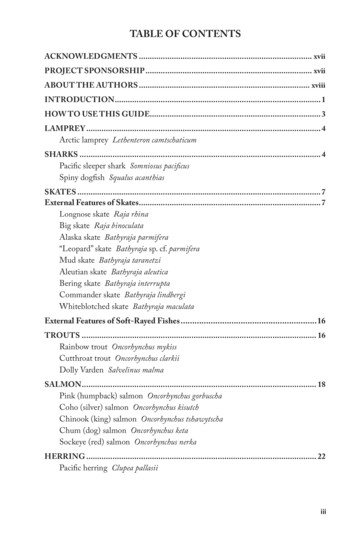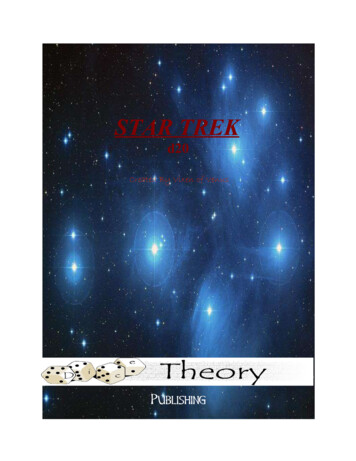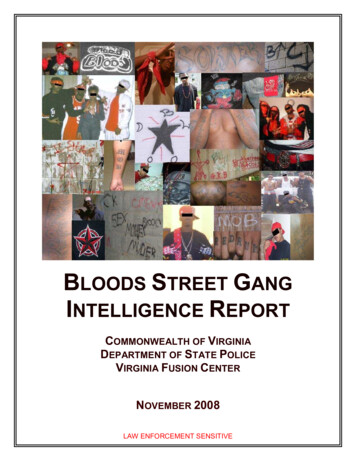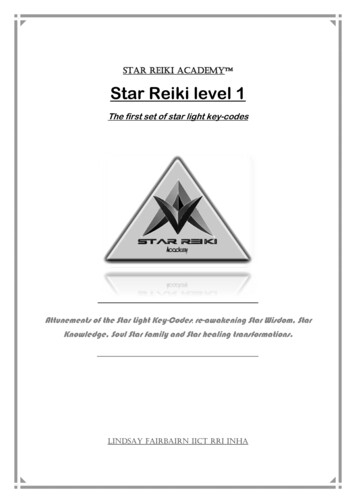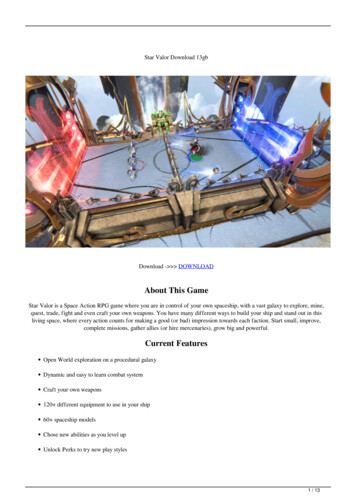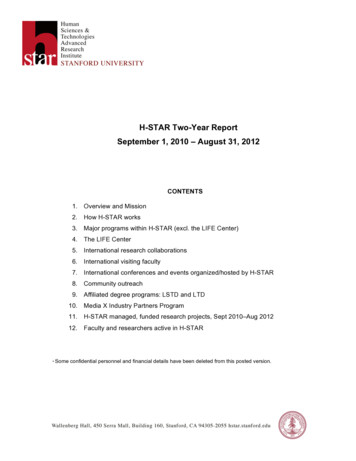
Transcription
H-STAR Two-Year ReportSeptember 1, 2010 – August 31, 2012CONTENTS1.Overview and Mission2.How H-STAR works3.Major programs within H-STAR (excl. the LIFE Center)4.The LIFE Center5.International research collaborations6.International visiting faculty7.International conferences and events organized/hosted by H-STAR8.Community outreach9.Affiliated degree programs: LSTD and LTD10.Media X Industry Partners Program11.H-STAR managed, funded research projects, Sept 2010–Aug 201212.Faculty and researchers active in H-STAR* Someconfidential personnel and financial details have been deleted from this posted version.
1. Overview and MissionH-STAR is a Stanford interdisciplinary research institute reporting to the Dean of the School ofEducation.1H-STAR focuses on advancing the human sciences, often in the context of their application tothe design and uses of information technology and their influences on people, with a particularemphasis on education and learning. All H-STAR programs conduct research at theintersection of human sciences and information technology in the areas of learning, mobility,collaboration, entertainment and commerce.H-STAR is the only organizational unit on campus focusing on the multi-disciplinary core oftheory, research, and methods that are needed for world-class work on the central topics inK-12 learning sciences and technology design. See Section 4 for a description of the NSFfunded LIFE Center’s research on these issues.While the primary mission of H-STAR is university research, H-STAR affiliated faculty members(listed in section 12) are among campus leaders in undergraduate education.Having a broad scope of interest that has commonalities with every School, H-STAR is definedby research mission rather than permanent faculty affiliation; we facilitate, fund, and supportresearch within our mission anywhere on the campus. All Stanford faculty are potentiallyH-STAR researchers. To date, a total of 64 (current) Stanford researchers from all five schoolshave carried out H-STAR supported research, participated in an H-STAR research planningretreat, or hosted a visiting H-STAR researcher from another university. (See lists in sections 6and 12.) In addition, some 90 Stanford faculty have received over 3.5M in research supportthrough H-STAR's Media X Industry Partners Program.Most of the faculty supported by H-STAR (listed in Section 12) are based social science andhumanities-affiliated departments (rather than engineering and research-equipment intensivedisciplines such as physics). Those disciplines typically do not have the extensive infrastructureneeded to support the large scale interdisciplinary research projects they wish to pursue. As aresult, H-STAR meets an important campus need that would otherwise go unfilled.H-STAR supported/affiliated researchers who submitted a report published a total of 33 booksand 535 research articles, and filed 4 patents.2 (A complete list is provided as an appendix.)We pursue our mission in a number of ways: we organize and service interdisciplinary grants,contacts, and other funding opportunities; we bring together faculty to work collaboratively onprojects — both across the campus and in collaboration with faculty at other universitiesaround the world; and we organize events such as lectures, small seminars, workshops andconferences, sometimes through our Media X program.1Following its formation in 2005, H-STAR initially reported to the Dean of Research. It was transferred to the School of Education foruniversity administrative reasons in July 2011.2About 30% of H-STAR faculty did not submit a report, so the actual totals are likely 30% higher.2
The total volume for federal and non-federal sponsored research funding awarded to H-STARin FY11 was 6.0M, of which 3.9M was F&A (indirect cost charges). For FY12, the figure was 6.5M with 4.0M F&A. See Section 9 for a complete listing of all sponsored projects.H-STAR employs 25 regular staff (academic and non-academic FTE), of which 5 employeesare performing shared administrative support functions, such as research administration,financial, human resources, and building management in two locations, Wallenberg Hall andCordura Hall. We also currently have 25 casual and temporary employees. BetweenSeptember 2010 and August 2012, under academic staff, we supported 30 graduate students.The primary source of funding for H-STAR research is the normal system of federal andfoundation grants.2. How H-STAR worksH-STAR provides such faculty (and their students and research assistants) with office space,physical and “virtual” meeting rooms (via IP videoconferencing), lecture rooms, lab space,seminars and lectures, printing and copying facilities, secretarial services, the services ofadministrative, financial and technical support personnel, assistance with identifying andsecuring funding for research, and, through the Media X program, contacts with industriesrelevant to their research pursuits.The primary means for funding H-STAR research is external grants, secured by the faculty andresearchers. The administrative and financial support staff of H-STAR provides help andsupport for faculty in proposal preparation and grant management.H-STAR also takes the initiative to secure large-scale, institute-level research funding thatprovides support to many institute faculty members when the opportunity arises. In particular,in 2004 the LIFE Center (Learning in Informal and Formal Environments) was established asone of the first three national Science of Learning Centers (SLCs) in partnership with theUniversity of Washington and SRI International. The NSF has funded the LIFE Center for themaximum ten-year period for a total of approximately 47M. This Center has supported facultyand students across education, communication, and psychology, and has served as atremendous interdisciplinary training ground for building capacity in the university forfundamental learning sciences research across schools and departments. LIFE-center fundeddoctoral students are now employed as professors in universities including: Keio University(Tokyo); Purdue; Teachers College, Columbia; UC Davis, U. Central Florida, Virginia Tech, andin universities and thinktanks and companies as postdocs or researchers or directors includingCMU, Durham University (UK), Institute of Play (Chicago), KidAdaptive.com, Microsoft GamingStudio, Sesame Workshop (Joan Ganz Cooney Center), SRI International, Stanford University,and the Tech Museum of Innovation (San Jose). LIFE Center faculty are among the corefaculty and governing board members for the new Center for Neurobiological Imaging (CNI:http://cni.stanford.edu/) that opened in Jordan Hall during 2011.LIFE Center faculty are among the core faculty for the new Center for Neurobiological Imagingthat opened in Jordan Hall during 2011.3
H-STAR has research space on the fourth floor of Wallenberg Hall, and administrative officesand research space in Cordura Hall. The Cordura Hall space comprises four administrativeoffices, three multi-person offices devoted to research projects, and a small conference roomcurrently used as an office due to lack of space.3. Major programs within H-STAR (excluding the LIFE Center)3a. Media X. H-STAR’s industry partnership program, Media X, is a self-funded program thatseeds campus-wide research and coordinates industry interest. The program currently includes14 industry partners. The program supports and funds research initiatives on domains involvingpeople and technology, rather than by discipline. Since the program began in 2001, Media Xhas supported more than 3.5M of Stanford research, spread across over 90 Stanford facultyPIs, receiving over 200 proposals, representing faculty from all seven schools, and involvingover 100 graduate students.Research funding from Media X has been in the form of seed grants to support earlyinvestigation of promising ideas that show likelihood of leading to larger projects. Media Xresearch funds are open to all researchers in the Stanford community, and preference is givento novel interdisciplinary collaborations. Many of these “seed” funded projects leverage largefederal and foundation grants (bringing faculty and student work closer to societal impactthrough commercial diffusion.) A significant number have led to new interdisciplinary proposalsfor federal and foundation grants that build on the Media X seed projects. (See Section 8 formore details about Media X.)3b. Energy Project This 6.2M, two-year project, commended in January 2010, focuses on thedevelopment of an interactive software system that encourages people to be more energyefficient at home. The funding includes 4,992,651 from the U.S. Department of Energy’sAdvanced Research Projects Agency-Energy (ARPA-E) and about 1.28 million in matchinggrants from Stanford and the California Energy Commission. The PI is Byron Reeves, who wasa co-founder of the H-STAR institute.3c. CTEL/CLAD CTEL stands for California Teacher of English Learners, and CLAD stands forCross-cultural, Language, and Academic Development. The Stanford Online CTEL/CLADProgram is a pioneering program of technology-enhanced learning, taught by Stanford Schoolof Education faculty Kenji Hakuta and Guadalupe Valdés and operated by H-STAR. Theprogram leads to the California CLAD credential, a professional K-12 teaching credentialrequired by the State for any public school teacher providing instruction to English Learners.As part of their coursework, participants in the Stanford Online CTEL/CLAD program analyzevideos of teacher practice in real classrooms and engage in carefully selected readings throughthree online courses. Participants learn about the latest methods in teaching English languagelearners and are introduced to education policy and the scientific fields of linguistics, humanlearning, and anthropology as they pertain to English learners. Since it began its onlineoperations in 2003, the Stanford Online CTEL/CLAD Program has serviced nearly2,400 teachers. The program has served over 100 school districts, the majority of which are inCalifornia. The Stanford CTEL/CLAD Program finished its last course on August 3, 2012 and iscurrently working to openly share its vast resources with educators nationally.4
Total number of program graduates to date: 2,373 studentsTotal number of enrollees in AY 2010-2012: 473Number currently enrolled: 0Among the school districts served by the program are:Albany Unified School DistrictAlisal Union School DistrictAlum Rock Union Elementary 2Amador County Office Of EducationAntioch Unified 2Archdiocese Of San Francisco, Dept Of CatholicSchools 4Atascadero Unified School District 8Auburn Enlarged City School DistrictBerkeley Unified School District 7Berryessa Union School DistrictBuffalo Public School 2Buttonwillow School District 2Calaveras County Office Of EducationCambrianCapistrano Unified 3Carlsbad UnifiedCarmel Unified School District 2Castro Valley UnifiedCupertino Union School District 4El Dorado Union School District 12Fort Bragg Unified School DistrictFremont Union High School District 7Gilroy Unified School District 2Glendora Unified School District 3Irvine Unified School DistrictJuneau School DistrictKing City Joint Union High School DistrictLake Elsinore Unified School DistrictLos Angeles Unified School District 15Lompoc Unified School DistrictLong Beach Unified 3Los Altos School District 3Los Gatos Saratoga UhsdMarin County Office Of Education 2Mendocino UnifiedModesto City Schools 3Montebello Unified 4Moraga Unified School District 3Newark Unified School District 2Novato Unified School DistrictOakland Unified 5Pajaro Valley Unified School District 5Palo Alto Unified School District 6Pasadena Unified 3Portola Valley School District 4Riverside Unified School District 10Sacramento City Unified School District 3San Bernardino City Unified School District 2San Carlos School District 5San Diego Unified School District 3San Francisco Unified School District 12San Jose Unified School District 6San Luis Coastal Unified School District 2San Mateo High School District 3San Ramon Valley Unified School District 5Santa Clara Co Office Of Education 4Santa Clara Unified School District 9Saratoga Union School District 7Sunnyvale School District 4Vallejo Unified School District 43c. Triple Helix Research Group. In July 2011, H-STAR co-organized and hosted the Triple Helix IXInternational Conference on University-Industry-Government Interactions. This was the first time in thefifteen year history of the Triple Helix Conference series that it had been held in Silicon Valley. Theconference addressed the theme “Silicon Valley: Global Model or Unique Anomaly?”Over 260 leading academics, prominent policy-makers and top business people, venture capitalists,business angels, consultants, and entrepreneurs from thirty-seven countries and all continents exploredthe inner workings of Silicon Valley and other international technology conurbations, analyzed strategicinnovation policy and practice issues in developed and developing countries, discussed the challengeand benefits of collaboration between the institutional spheres of university, industry, and government,show-cased best practice, explored new models for knowledge transfer and entrepreneurship, andappraised the success and challenges of the university third mission.5
4. The LIFE CenterThe National Science Foundation (NSF) has been funding Science of Learning Centers (SLCs)in order to extend the frontiers of knowledge on learning of all types and create the intellectual,organizational, and physical infrastructure needed for the long-term advancement of learningresearch. Launched in Fall 2004, the Learning in Informal and Formal Environments (LIFE)Center is now in its eighth year of a ten-year research collaboration between the University ofWashington in Seattle (College of Education, and Institute for Learning & Brain Sciences).H-STAR, SRI International and other partnering institutions. H-STAR Institute Director Roy Peaserves as Stanford University Co-Director and Co-PI of the LIFE Center, leading Stanford’scontributions to this scientific center.The purpose of the LIFE center (http://www.life-slc.org) is to develop and test principles aboutthe social foundations of human learning in informal and formal environments, including howpeople learn to innovate in contemporary society, with the goal of enhancing human learningfrom infancy to adulthood.The Center is engaged in many interdisciplinary studies of learning, incorporating diversemethodologies such as brain imaging, comparative experimentation, ethnographic inquiry andvirtual reality. From its inception, LIFE Center research incorporated three academic traditions.LIFE’s socio-cultural research tradition relied on ethnographic, interview, and survey methodsto document the impact of culture and social activities on learning in and out of school. LIFE’sexperimental and neural studies used behavioral and neuroscience methods to document themechanisms underlying social learning from a developmental and neural perspective, showingthe deep reach of culture on the developing individual’s mind and brain. LIFE’s work on formallearning and technology examined teachable agents and learning in designed learningenvironments. LIFE’s Center-mode work integrated these traditions into a set of six "SocialLearning Drivers" that need to be taken into account in any transformative theory of the socialfoundations of human learning. Collectively, these six can be viewed as an integrative networkof concepts that need to be explored separately and as an integrated whole in order to betterunderstand social learning. The six are: (1) Imitation & Joint Attention, (2) Language, (3)Identity, (4) Guiding & Collaborating, (5) Choosing & Valuing, and (6) Simply Believing a VirtualInteraction is Social.LIFE has two Missions to achieve its Purpose: To identify and investigate underlying principles of how people learn socially bystrategically sampling learning across settings, domains, and ages, and by usingmultiple methodologies (neurobiological, cognitive, developmental, and socio-cultural)to spark conceptual collisions and syntheses among viewpoints. To foster research and education collaborations with individual and institutionalpartners, and to promote qualitative improvements, both theoretical and practical, in ourcollective capacities for understanding and supporting human learning.Stanford faculty leading LIFE projects include LIFE leadership group Professors Roy Pea(Stanford Co-PI and Co-Director), and Co-Leads Brigid Barron and Daniel Schwartz (formerLIFE Co-Director), with contributing faculty Professors Jeremy Bailenson, Byron Reeves,6
Shelley Goldman, Anthony Wagner, Paulo Blikstein and Geoffrey Cohen. Over twenty doctoralstudents, postdocs and staff are involved in LIFE Center research work each year as well5. International research collaborationsH-STAR has several international collaborations with universities and industries throughoutEurope and Asia. The most significant during the period 2010–12 are listed below:5a. Finland H-STAR has had close ties with Finnish universities for several years, focused onresearch on education and the human-centered design of technology, both areas where bothFinland and Stanford have international reputations. Throughout the two-year period of thisreport, the Finnish government technology agencies (TEKES) has funded Stanford’sinfrastructure costs in supporting research collaborations on the Stanford campus betweenuniversity scholars from Finnish universities, working on projects with Stanford faculty PIs.In October 2010, H-STAR co-organized and hosted a three-day Finnish-Stanford researchworkshop on Learning, Learning Environments, and Technologies.In January 2012, in conjunction with the Finnish Consul General in Los Angeles, and assistedby Stanford’s SCOPE center, H-STAR organized a high level, two day conference titled“Empowerment through Learning in a Global World. ”The enormous success of the Finnisheducation system in recent years has made them the envy of the world. The workshop focuseson the question: How did they do it, and what can we in the USA learn from the Finnishexperience? Distinguished international speakers included Andreas Schleicher, Special Advisoron Education Policy to the Secretary General of the OECD, the man is charge of theinternational PISA tests of educational achievement, Pasi Sahlberg, the Director of the Centerfor International Mobility, Finland, and the author of the bestselling book FINNISH LESSONS:What Can the World Learn from Educational Change in Finland?, Henry Tirri, Executive VicePresident and CTO of Nokia, Sue Burr, Executive Director of the State Board of Education,State of California, Krista Kiuru, Minister of Housing and Communications, Finland, EskoHamilo, Under-Secretary of State, External Economic Relations, Ministry of Foreign Affairs ofFinland, and Markku Mattila, President of the Academy of Finland.Of particular note, frequent Stanford visiting professor Jari Multisilta from Finland (TampereUniversity, and later University of Helsinki as CICERO Director), and former Vice-ChancellorProfessor of University of Helsinki (and Stanford visiting professor) Hannele Niemi representedFinland at the creation of a new NSF program – SAVI (Science Across Virtual Institutes) – thatwas designed for US and Finnish faculty to collaborate on learning technology projects(convened at the Finnish Embassy in DC in June 2012, and leading to Stanford University andFinnish faculty collaborative projects being funded in summer-autumn 2012). Funding will beginin Winter 2012-2013 on both sides of the Atlantic.5b. Denmark Paralleling the H-STAR partnership with the Finnish university system, we have asimilar, ongoing research collaboration with the Danish university system, funded by the DanishAgency for Science, Technology, and Innovation (DASTI). As with the TEKES-fundedpartnership with Finland, DASTI has funded Stanford’s infrastructure costs in supportingresearch collaborations on the Stanford campus between university scholars from Danishuniversities, working on projects with Stanford faculty PIs.7
During the two-year period of this report H-STAR hosted a number of visits by Danishgovernment ministers and officials, including a large visiting group in August 2011 from AalborgUniversity, which is interested in establishing a collaborative research project with H-STAR. HSTAR Executive Director Dr. Keith Devlin made several visits to Denmark during the same twoyear period.H-STAR also hosted several Danish-Stanford research workshops. In addition H-STARorganized and hosted three three-day research workshops in which Danish research interactedwith Stanford colleagues: two on business innovation (February 2011 and May 2011, the latterco-sponsored by the European Union) and one that took an in depth examination of Virtualityfrom various disciplinary perspectives (May 2011).5c. Sweden Through its prior management of the Wallenberg Foundation grants to Stanford,H-STAR developed regular contacts with scholars in Swedish universities, and frequently hostsvisitors from Sweden. H-STAR played a supporting and facilitating role in preparing theproposal for the new award from the Wallenberg Foundation that commenced in 2011. We arecurrently engaged in a number of discussions about future research collaboration with Swedishuniversities.5d. Norway Norwegian Science Week. The Norwegian Transatlantic Science Week,sponsored and arranged by the Royal Norwegian Embassy in Washington, D.C., is an annualevent. Every second year it is held in Washington DC and the other years in various US cities.In 2011, it was held on the West Coast for the first time, with a two day conference at USBerkeley followed by a one day conference at Stanford. At the request of Provost JohnEtchemendy, H-STAR undertook the task or organizing the Stanford day on November 27.The main goal of Science Week is to increase transatlantic cooperation in research, innovationand higher education. The Norwegian government aims to facilitate and increase cooperationbetween Norway and North America and initiate bilateral agreements on science andtechnology cooperation. Participants included policy makers, innovators, educators, andresearchers.The Stanford conference offered talks and pane discussions on Silicon Valley, microelectronicsand nanotechnology, knowledge-based industries, big ICT systems, research-basedinternational graduate education, and energizing research and education through innovation.The day ended with a banquet at the Computer History Museum, with an illustrated lecture byStanford Physics Professor Phil Scherrer, on “New Views of the Sun from the Solar DynamicsObservatory.”5e. Estonia Under the leadership of H-STAR Executive Director Dr. Keith Devlin, H-STAR hasengaged in a number of ad hoc collaborations with Estonia, now acknowledged as one of theworld’s leading nations in innovation, particularly in the ICT sphere. During the two-year periodcovered by this report, Devlin visited Estonia three times (November 2010, June 2011, andDecember 2011), meeting with Estonian government ministers and academics, and hosted fourvisits by Estonian government ministers, industry leaders, and academics (April 2011, June2011, November 2011, and April 2012).5f. Germany Several H-STAR researchers have strong links to colleagues at Germanuniversities. H-STAR faculty co-developed in the 2004-2006 period an international series ofresearch workshops, funded by NSF in the USA and the DFG in Germany, on network-8
supported collaborative learning, which have led to continued collaborative research, jointpublications and enriched mutual influences across a knowledge network of 10 Americanuniversities and 7 German universities. One new journal, the International Journal ofComputer-Supported Collaborative Learning (iJCSCL, published by Springer/Kluwer) wasinitiated as a result of these developments, and H-STAR Director Roy Pea is on its EditorialBoard. It is now one of the highest impact factor journals in educational research in the Web ofScience.5g. Taiwan H-STAR developed a partnership with the Center for Learning Sciences andTechnology at Taiwan’s National Central University, invited by Center Director Professor TakWai Chen and a delegation to Stanford including Taiwan’s Deputy Director of the Ministry ofEducation. H-STAR Director Roy Pea has advised Center Director Tak Wai-Chen in hisformation of the G1:1 initiative, to which HSTAR has extensively contributed. G1:1 was apioneering global one-to-one computer to learner initiative with participation for over twentycountries, a devoted website to projects, results, tools and datasets, and a sponsor of overabout a dozen conferences on the subject with professional societies such as IEEE. The aimis developing global collaborative research models on 1:1 personal (and increasingly mobile)computer learning (http://www.g1on1.org). Many country-specific 1:1 learner:computer modelshave developed globally since these 2005-2006 origins.6. International visiting facultyIn addition to H-STAR’s international collaborations, we act on behalf of Stanford faculty toorganize and support visiting faculty collaborators. We organized and supported 13 visitingfaculty from overseas in 2010–11 and 25 visiting faculty from overseas in 2011–12. Thedepartments of the hosting Stanford faculty were School of Education (13 visitors), Dept ofCommunication (8), Dept of Mechanical Engineering (8), Stanford Humanities Lab (5), Dept ofElectrical Engineering (1), Dept of Psychology (1), Dept of Anthropology (1), Dept of ComputerScience (1).2010–11Jari Multisilta, Dept of Information Technology, Tampere University of Technology, Pori, Finland.July 2010 - December 2010. Working with Roy Pea, H-STAR.Hannele Niemi, Faculty of Behavioural Sciences, CICERO Learning Network, University of Helsinki, Finland.September 2010 - November 2010. Working with Roy Pea, H-STAR.Arttu Perttula, Tampere University of Technology, Pori, Finland.September 2010 - November 2010. Working with Roy Pea, H-STAR.Lassi Liikkanen, Helsinki Institute of Information Technology, Helsinki, Finland.September 2010 - August 2011, working with Cliff Nass, Dept of Communication.Mohsen Soltani, Department of Electronic Systems, Aalborg University, Denmark.September 2010 - December 2010. Working with Stephen Boyd, Dept of Electrical Engineering.Peter Lindgren, International Center for Innovation, Aalborg University, Denmark.September 2010 - February 2011. Hosted by Jeffrey Schnapp, Stanford Humanities Lab.Ole Jensen, Department of Management Engineering, Technical University of Denmark.September 2010 - March 2011. Working with Larry Leifer, Dept of Mechanical Engineering.9
Heidi Enwald, Dept of Information Studies, University of Oulu, FinlandJanuary 2011 - March 2011. Hosted by Byron Reeves, Dept of Communication.Kerstin Fischer, IFKI, University of Southern Denmark, DenmarkFebruary 2011. Working with Herbert Clark, Dept of Psychology.Jerry Lindholm, Dept of Marketing, Aalto University, Helsinki, Finland.March 2011 - September 2011. Hosted by Byron Reeves, Dept of Communication.Remzi Ates Gursimsek, Dept of Communication, Business & Information Technologies, Roskilde University, DenmarkMarch 2011 - June 2011. Hosted by Michael Shanks, Stanford Humanities LabFalk Heinrich, Dept of Communication, Aalborg University, Denmark.April 2011 - July 2011. Hosted by Michael Shanks, Stanford Humanities Lab.Jeonghye Han, Dept of Computer Education, Cheongju National University of Education, KoreaFebruary 2011 - January 2012. Working with Roy Pea, H-STAR.2011–12Miikka Eriksson, Faculty of Education, Centre for Media Pedagogy, University of Lapland, Finland.August 2011 - July 2012. Working with Roy Pea, H-STAR.Pekka Aula, Dept of Social Research, University of Helsinki, Finland. August 2011 - July 2012. Working with Larry Leifer,Center for Design Research.Jeonghye Han, Dept of Computer Education, Cheongju National University of Education, KoreaFebruary 2011 - January 2012. Working with Roy Pea, H-STAR.Tim McAloone, Dept of Management Engineering, Technical University of Denmark (DTU), Denmark.September 2011 - December 2011. Working with Larry Leifer, CDR.Bettina Dahl Soendergaard, Centre for Science Education, Aarhus University, Aarhus, Denmark.September 2011 - November 2011. Working with Roy Pea, H-STAR.Sanne Haase, Danish Centre for Studies in Research and Research Policy, Aarhus University, Denmark.September 2011 - November 2011. Working with Sheri Sheppard, Dept of Mechanical Engineering.Christina Neumayer, IT University of Copenhagen, Copenhagen, Denmark.September 2011 - December 2011. Working with Fred Turner, Dept of Communication.Michael Biskjaer, Dept of Information and Media Studies, Aarhus University, Aarhus, DenmarkSeptember 2011 - December 2011. Working with Larry Leifer, CDR.Xibin Han, Institute of Education, Tsinghua University, Beijing, China.September 2011 - December 2011. Working with Roy Pea, H-STAR.Birgit Jaeger, Dept of Society and Globalization, Roskilde University, Roskilde, Denmark.September 2011 - December 2011. Working with Banny Banerjee, Dept of Mechanical Engineering.Akihisa Kaneko, Sony Corporation, Tokyo, Japan.September 2011 - September 2012. Hosted by Byron Reeves, Dept of Communication.Nevena Jensen, Aarhus School of Architecture, Kolding School of Design, Kolding, Denmark.October 2011 - November 2011. Working with Larry Leifer, CDR.Ursula Plesner, Dept of Organization, Copenhagen Business School, Denmark.October 2011 - December 2011. Working with Michael Shanks, Stanford Humanities Lab.Kaarina Nikunen,Swedish School of Social Sciences, University of Helsinki, Helsinki, Finland.January 2012 - December 2012. Hosted by Byron Reeves, Department of Communication.10
Saana Korva, Faculty of Education, Centre for Medi
Santa Clara Co Office Of Education 4 Santa Clara Unified School District 9 Saratoga Union School District 7 Sunnyvale School District 4 Vallejo Unified School District 4 3c. Triple Helix Research Group. In July 2011, H-STAR co-organized and hosted the Triple Helix IX International Conference on University-Industry-Government Interactions.

